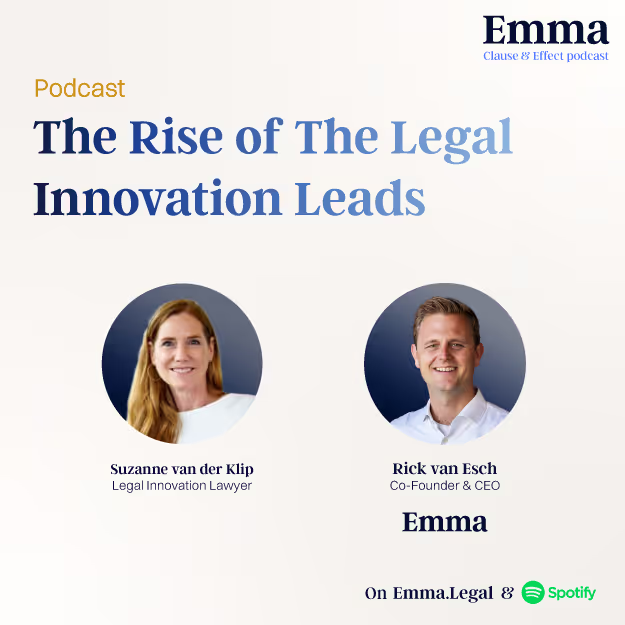Law firms aren't just adding AI tools. They're fundamentally transforming how legal work gets done. In this interview, a veteran lawyer turned innovation lead shares insights on driving successful AI adoption in legal practice.
Recorded: July 2025
From Practice to Innovation
Suzanne van der Klip's career began like that of many lawyers: corporate transactions, litigation matters, and countless late nights. What distinguished her trajectory was a persistent focus on operational efficiency. She built templates, standardized drafting processes, and became an early adopter of legal technology.
While those early tools showed promise, they often required significant configuration and rarely delivered on their full potential. Then came generative AI. In early 2023, when she first encountered an enterprise-grade legal AI system, she recognized a paradigm shift.
"Innovation is the daily grind of trying to improve, not a one-hit wonder," she explains. This philosophy shaped her transition into a role dedicated to modernizing legal service delivery.
Defining the Innovation Lead Role
The legal innovation lead position isn't a theoretical exercise removed from client work. It's a strategic connector role focused on transforming promising pilots into scalable, repeatable processes. Core responsibilities include:
- Mapping technology capabilities to concrete use cases rather than abstract features
- Training teams on practical tool deployment and identifying genuine value-add applications
- Developing implementation roadmaps that secure leadership support
- Demonstrating progress through measurable outcomes and enhanced workflow safety
- Partnering with vendors and, where necessary, developing proprietary solutions
On the build-versus-buy question, Suzanne's firm pursued both paths. They evaluated commercial legal AI platforms while simultaneously developing an internal AI-powered drafting and negotiation solution built on the firm's institutional knowledge and best-practice precedents.
The key insight: lawyers adopt tools that demonstrably improve their next deliverable, not those that simply demo well.
Organizational Change, Not Just Technology Deployment
Implementing AI and legal technology across a law firm requires a structured plan and a staggered approach. Success depends on demonstrating clear value propositions to stakeholders at every organizational level. As Suzanne notes, "you need senior buy-in and bottom-up traction simultaneously."
You won’t convince anyone with features. You have to go to every different team and show them a use that is relevant to them. Show them better output for their own work, and adoption follows.
Due Diligence: The Irresistible Use Case
Having coordinated legal due diligence reviews for years, Suzanne understands the process's inherent challenges: manual review at scale, compressed timelines, and zero margin for error. Modern legal-grade AI, with secure document upload capabilities for large data sets, addresses these pain points directly.
"Due diligence is the irresistible use case for generative AI in legal practice," she observes.
As Emma sees firsthand every day, the value is twofold. First, AI accelerates the review process by sorting, categorizing, and summarizing thousands of documents against predefined checklists, allowing reviewers to work at speed rather than starting from scratch. Second, it enhances quality through systematic clause comparison, anomaly detection, and clearer risk flagging.
The result isn't a replacement for legal judgment, it's better-informed judgment.
The Model Question: A Pragmatic View
Considerable debate surrounds whether legal practice requires domain-specific AI models or robust orchestration layers on top of general-purpose models. From the practitioner's perspective, Suzanne remains pragmatic: "Whatever delivers the best output."
Winning systems typically combine three elements:
- Workflows that mirror actual legal delivery processes
- Firm-specific data that grounds outputs in proven precedents
- Powerful underlying models with reliable reasoning capabilities
Whether the "legal intelligence" resides in the model itself or the surrounding architecture matters less than producing safer, higher-quality work product today
Balancing Perfectionism with Iterative Development
Law firms are based on achieving the best quality output, not beta software. Yet innovation requires experimentation. The solution lies in tight feedback loops and transparent progress tracking. Suzanne recommends:
- Beginning with controlled, narrow pilots connected to active matters
- Establishing clear review protocols and quality thresholds
- Tracking progress through objective, measurable metrics
- Expanding only when evidence clearly supports scaling
This approach builds confidence without dismissing legitimate risk concerns. It also reframes AI as a collaborative tool. As Suzanne describes it, treat the technology "like an associate or junior lawyer on your team," using it to expand analytical perspectives rather than outsource critical thinking.
Lessons from the Deal Floor
When asked about memorable M&A experiences from her practice days, Suzanne recalls a controlled auction that extended through the night. The seller maintained competitive tension between two bidding teams, including Suzanne's client, until the final signing moment. When faced with an eleventh-hour price increase, her team held their position and lost the deal.
After the initial disappointment passed, the client knew it had been the right decision. The winning bidder had overpaid. With the preserved “war chest” the client funded a better deal six months later.
The lesson translates directly to AI implementation: don't just chase novelty. Anchor decisions to demonstrable value, empirical evidence, and strategic discipline. Win the right way.
Practical Guidance for Legal Innovation
The path forward for legal AI adoption is clear: maintain an experimental mindset, particularly in a profession historically resistant to change. Begin with repetitive, risk-bounded work, and pair every new capability with appropriate training and review mechanisms.
Build institutional competence around workflows, not gimmicky features.
As Suzanne concludes: "Make friends with generative AI. It delivers better insights faster, when you use it well."
Other related podcasts

Building Emma: The Architecture Behind Reliable Legal AI
A deep dive into how Emma builds reliable legal AI for M&A due diligence. Co-Founder Pieter Buteneers explains why LLMs excel at structured legal review, why prompt-driven workflows outperform “magic agents,” and how step-based, auditable processes cut review from weeks to hours. From model selection to security, completeness checks, risk scanning, and human-in-the-loop judgment, this episode shows the architecture behind trustworthy, fast, and defensible diligence.
Read

The Rise of The Legal Innovation Leads
Discover how law firms are embracing legal innovation beyond buzzwords. In this interview, Suzanne van der Klip, M&A lawyer-turned-innovation lead shares how to drive real AI adoption in legal workflows from due diligence to deal execution.
Read

Europe vs US deal habits that reshapes your M&A playbook
Europe vs US M&A deal habits: from locked box pricing to disclosure letters and W&I insurance that reshapes your playbook. Learn how to navigate key differences and turn them into deal-closing advantages.
Read
